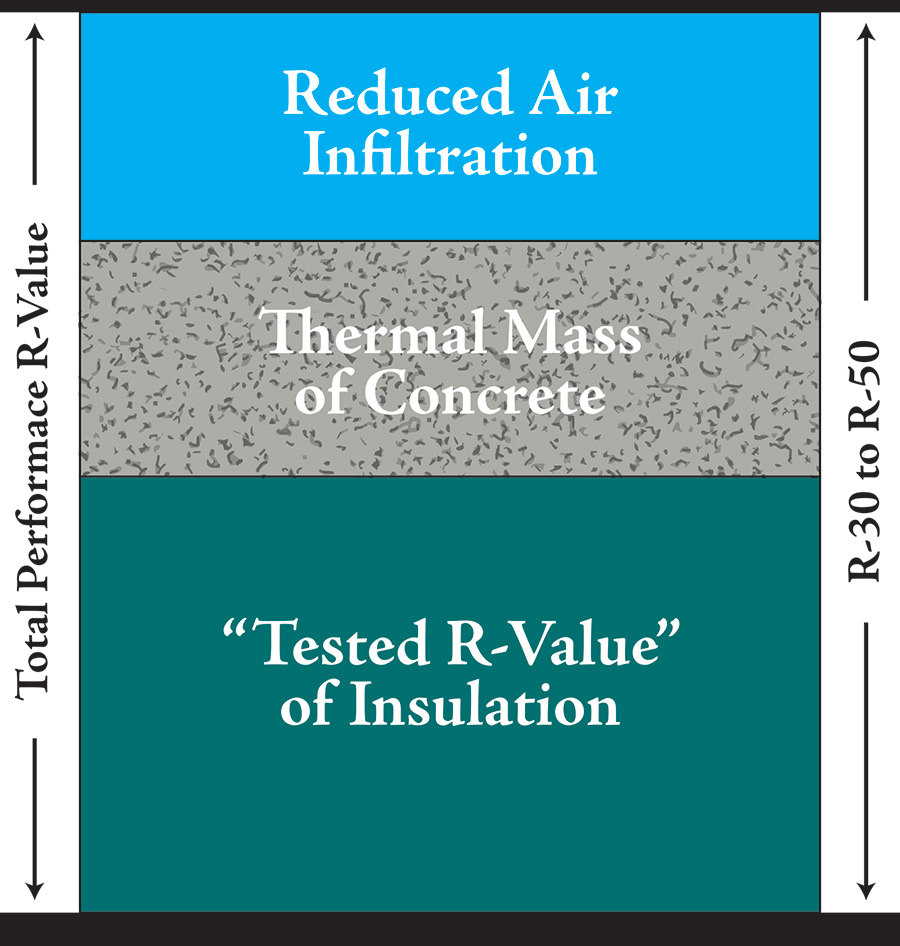An Original Article by Larry Reid for ICF Mag
Houses constructed with commercially available ICFs have a greater resistance to heat transfer (measured as R-values with higher values being better) than is apparent from measures of R-values in the laboratory. The insulation of commercially available ICFs is usually 2.5 inches of foam used as forms to construct concrete walls. Given that 2.5 inches of foam has an R-value of about 11 and there are two of them (one that will be on the outside of a concrete wall and one that will be on the inside of the wall) and given that concrete has virtually no R-value, the conclusion is that ICF walls have an R-value of about 22. An R-value of 22 is only moderately good and is often lower than achievable with alternative building materials and the insulation typically used with those materials. Those who experience living in a house built using ICFs and the manufacturers of ICFs both conclude that the R-value is higher than is apparent by adding the laboratory-established R-values of the two layers of foam. The assertion is that ICFs have a “practical” R-value that is on the order of 50, a value that is usually better than achieved using alternative materials.
The apparently higher, practical R-value is attributed to the fact that ICF-built walls have few, if any, cracks or places without insulation (e.g., cold corners) and, therefore, are free of drafts. A second feature is also advanced as an explanation for the difference between the practical R-value and the calculated R-value from testing of the constituent materials: The mass of the concrete materials supposedly accounts for the apparent difference.
Both the steel reinforcements used with some ICF walls and the concrete itself have no insulating value and, in fact, both conduct energy. The fact that the concrete and steel are conduits of heat and, thereby, achieve the temperature of their surroundings is the basis for another explanation of the high R-values achievable using ICFs. When there is contiguity between the concrete of an ICF wall, the concrete of the footing for those walls and the earth, there is a strong possibility for there to be transfer of heat from the earth to the footing to the interior of the wall. When the footing is, as usual, about four feet below the surface, the earth next to the footing is about 55°F. Given the conductivity of concrete, the concrete of an ICF wall can stabilize at about 55°F.
If the concrete of an ICF wall tends to be about 55°F, the concrete becomes an insulator against temperatures that deviate from 55°F. ICF walls can become passive geothermal heat sources. When the top of an ICF wall is insulated, the heat of the earth can be contained within the walls of a building. The net effect is that the foam of the interior wall has only to provide resistance to heat transfer from 72 to 55°F to provide winter-time comfort. A wall with a 55°F interior would be effective in the summer. In the summer-time, it is known that basements are cooler, because the usual concrete walls and floors of basements stabilize at their surrounding earth’s temperature. The same principle that accounts for the usual cooler basements will account for the superior ability of an ICF wall to provide resistance for transfer of heat.
What are the implications of coming to appreciate the potential for ICF walls to be passive geothermal heat sources? One implication is that the usual explanation of the superior insulating value of ICF walls, which relies on the concept of mass, needs to be revised. Accumulating mass of a material that is a good, but not perfect, conductor of heat will not provide greater insulation (adding near zeros does not add much). The mass merely allows for stability, i.e., it takes longer to heat a large amount of concrete to say 55°F than a small amount of it and it will take longer for the heat from a large amount of a heated piece of concrete to dissipate to the surrounding temperature than a smaller amount. Once the concrete of an ICF wall stabilizes to say 55°F, its mass will resist rapid change. The greater mass will provide superior insulation from winter-cold only if one side of the concrete of a wall is in contact with warm earth and surrounded with insulation on the other three sides.
With the entertainment of the idea that an ICF wall can become a passive geothermal heat source, a number of questions become apparent. Research, for example, can be directed toward answering questions such as how much contact with earth and at what depth is optimal to achieve the functional equivalent of excellent insulation from temperature changes. Is it necessary for the top of the wall to be insulated to get considerable benefit from ground heat? Should there be different building practices (e.g., depth or kind of footings) for the deserts of Arizona compared to the plains of Canada to achieve less energy expenditure for indoor comfort? Perhaps the most interesting perspective is: How might the current practices for geothermal heating be incorporated into building practices using ICF walls? The research to answer some of the most obvious questions is straightforward and not expensive to conduct, but first one has to come to appreciate a unique feature of ICFs (well, not really unique because adobe homes can have, but not necessarily have, similar features).
Larry Reid is professor at Rensselaer Polytechnic Institute, Troy, NY.






